Aidan Kiley
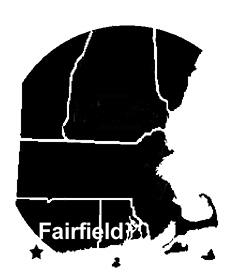 The Roy and Margot Larsen Sanctuary in Fairfield, Connecticut, is one of the Connecticut Audubon Society’s (CAS) most well-known destinations for birders and naturalists alike. It is a landmark location for Connecticut birding. The 184-acre sanctuary features an extensive trail system with more than seven miles of trails that cover many habitats, such as small marshes, streams, a swamp, open meadows, and forests. Nearly 200 species of birds have been observed here, including many uncommon species as well as a handful of rarities. It is an easy destination to bird, with well-marked trails; maps are available from the Connecticut Audubon Society. The CAS website has a checklist of the species that have been recorded on the property.
The Roy and Margot Larsen Sanctuary in Fairfield, Connecticut, is one of the Connecticut Audubon Society’s (CAS) most well-known destinations for birders and naturalists alike. It is a landmark location for Connecticut birding. The 184-acre sanctuary features an extensive trail system with more than seven miles of trails that cover many habitats, such as small marshes, streams, a swamp, open meadows, and forests. Nearly 200 species of birds have been observed here, including many uncommon species as well as a handful of rarities. It is an easy destination to bird, with well-marked trails; maps are available from the Connecticut Audubon Society. The CAS website has a checklist of the species that have been recorded on the property.
Larsen Sanctuary can be productive for birding in all seasons, but it is best known for spring migrants and summer breeders. The woodlands are a popular spot for many types of passerine migrants in spring. The woods surrounding the nature center and Farm Pond can hold substantial warbler flocks. Canada, Magnolia, Wilson’s, and many other species can be found there. The Chiboucas Trail loop is an easy walk on a May morning or afternoon. The Wildlife Pond often attracts passerine flocks and holds a handful of American Bitterns. The nearby meadow attracts open-habitat dwellers such as Prairie Warbler, Blue-winged Warbler, Common Yellowthroat, and Indigo Bunting.
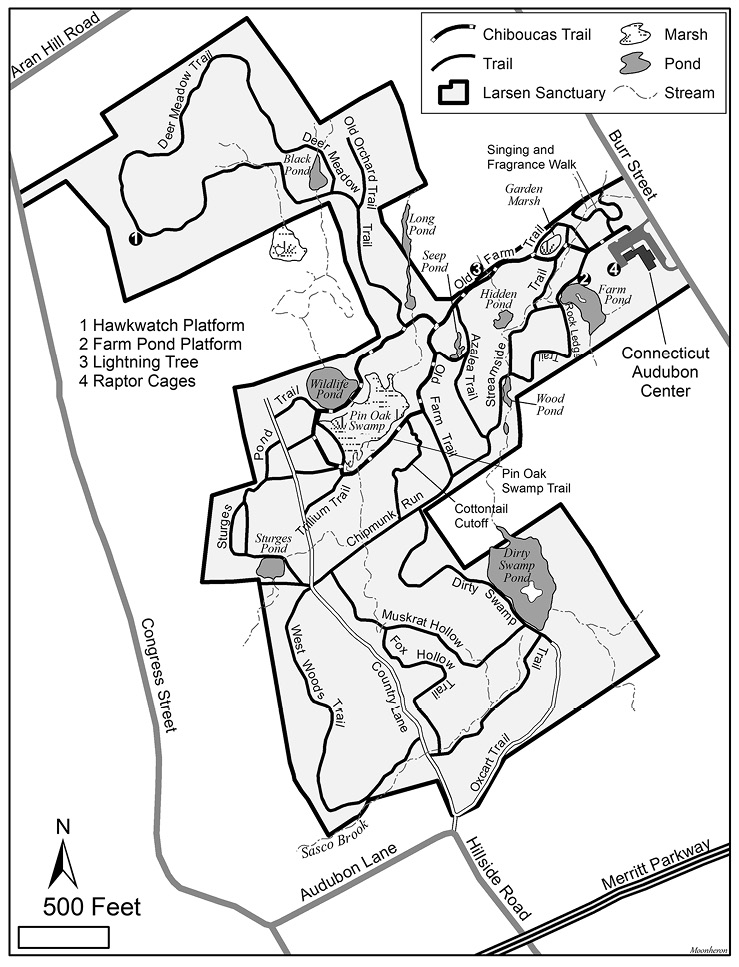
Map of Roy and Margot Larsen Sanctuary, Fairfield, Connecticut
Trails
Chiboucas Trail: The most popular trail is the Edna Strube Special Use Chiboucas Trail, which is a flat, easily accessible path. Start at the main trailhead across from the nature center, pass the Garden Marsh on the right, and continue into a small meadow. Eastern Bluebirds nest in the boxes, and the conifers in the area are productive for warblers, and especially Ruby-crowned and Golden-crowned kinglets in the fall. A winter walk in this area may provide an opportunity to find Golden-crowned Kinglets, Winter Wrens, Brown Creepers, and more. Continue past the marsh and meadow until you come to the intersection at the Deer Meadow Loop. The densely wooded areas near the trailhead are good for thrushes. Veery is a specialty breeder, and during migration, this area is a good bet to find Hermit, Swainson’s and Gray-cheeked thrushes in season. Wood Thrush is also possible as a rare breeder and migrant in the preserve.
Continue straight past the Deer Meadow trail until you come to the Wildlife Pond. This is one of the best-known locations in the sanctuary. The pond is surrounded by tall grass, with an island in the middle where Red-winged Blackbirds nest. On the south shore of the pond is a boardwalk with dense brush on the edge of it. House Wrens, Blue-winged Warblers, Yellow Warblers, and Common Yellowthroats all breed in this area. In migration, the vegetation bordering the pond can hold flocks of warblers, vireos, and sparrows. Prothonotary Warbler has occurred just around the boardwalk. There are a handful of records of American Bittern at the pond. This is a rare species in Fairfield, and Wildlife Pond has been the most frequent spot for bitterns in recent years.
Around the bend from the Wildlife Pond, you enter the main meadow of the sanctuary. This is a good vantage point to look for flyover raptors as well as breeding and migrant passerines. The trail cuts through the meadow then circles Pin Oak Swamp, which provides water and food for many species. The tall dead trees here are good for woodpeckers. After walking past the swamp, follow the trail to the Old Farm or Azalea trails to explore a new area or continue back down the Chiboucas Trail to return to the nature center.
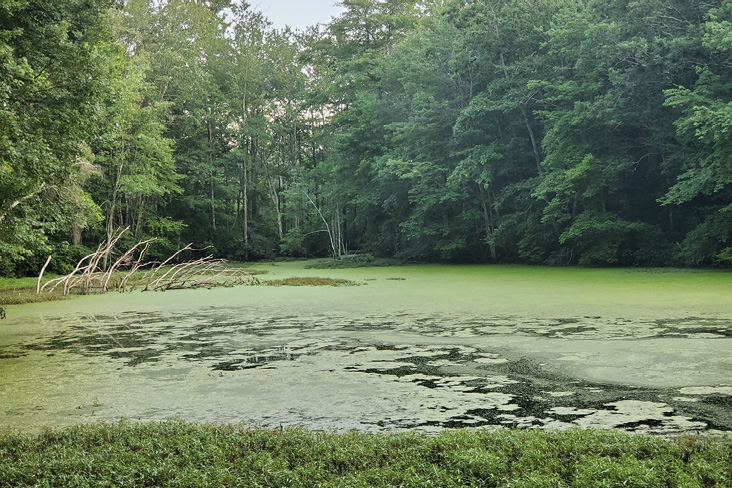
Farm Pond. Photograph by Aidan Kiley.
Streamside Trail: The Streamside Trail, which is accessible from the main Chiboucas Trail, is a boardwalk along a swampy stream. It is nice and crisp on a cool spring or fall morning. Louisiana Waterthrush nests along the trail, along with more common passerines. This is often a great place to hear an array of warbler songs on a May morning. Yellow-throated and Prothonotary warblers have occurred here in the past few years. This swampy area has the appearance of a more southern habitat, which may have attracted these spring overshoots. The boardwalk along the stream borders masses of skunk cabbage and other low-lying plants that are quite inviting to many species.
Deer Meadow Trail: The Deer Meadow is accessible from the Chiboucas Trail. It is a loop that covers deep, dense woods before opening up to a large meadow. The multitudes of goldenrod and ragweed are perfect for sparrows, and you should look for Connecticut Warbler, although it has not been seen in recent years. The hawkwatch platform is a fantastic spot for morning flight. Standing there for a few hours after sunrise will provide finches, warblers, sparrows, kinglets, and waterfowl flying over before raptors pick up once the thermals begin to form. Flocks of Northern Pintails, Green-winged Teal, and Common Mergansers have flown over in recent autumns. Finches, American Pipits, various thrushes, and flocks of swallows all may be encountered. On a day of north or northwest winds, especially after a cold front in September or October, this platform is certainly worthy of a visit. It is no longer actively an official hawkwatch site, but it is still a good spot to spend some time looking for eagles, vultures, and hawks.
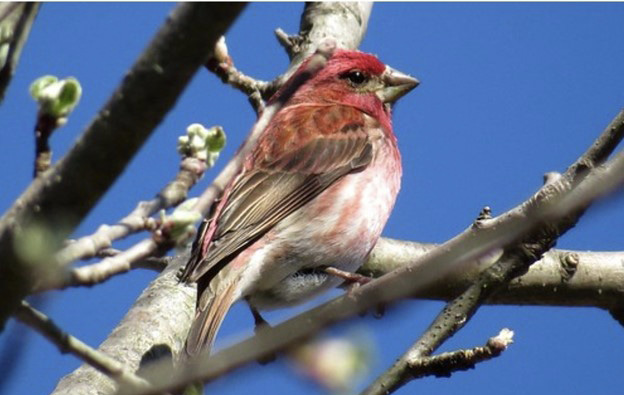
Purple Finch. Photograph by Erika Kiley.
Nature center and feeders: In the winter, I enjoy spending time at the feeders around the building. It is historically excellent for finches, with Purple Finches and Pine Siskins easily found in irruption years. It always merits a brief check, because there is a February record of Western Tanager. The sunflower mix, niger, and suet feeders attract a wide variety of common species. In the winter, Yellow-bellied Sapsuckers and Brown Creepers are regular visitors. The pond behind the building is Farm Pond. It can hold ducks in the winter, but nothing rarer than Green-winged Teal or American Wigeon. The pond’s platform provides an excellent view of the whole area. Wood Ducks breed on the pond, and you can see chicks around by early summer. Most years there is an Eastern Phoebe nest close to the platform. One August record of a juvenile Least Bittern is likely the best bird that has been spotted at Farm Pond in recent years. On a good migration day, it is always worth a check near the boardwalk and the pond shore for passerines. Often there will be a small warbler flock, sometimes containing Canada, Chestnut-sided, Magnolia, Black-throated Blue, and the more common warblers. In the early morning the sunlight hitting the trees on the edge of the pond no doubt draws them in.
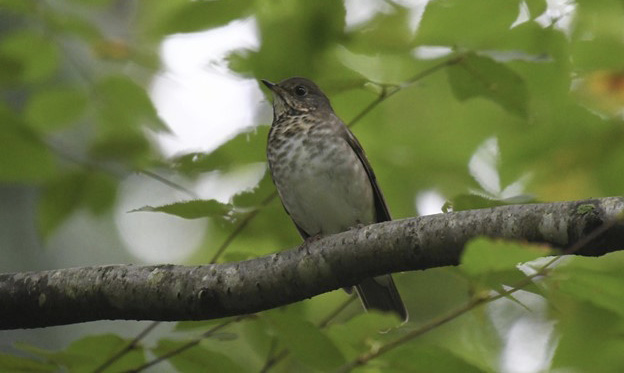
Gray-cheeked Thrush. Photograph by Aidan Kiley.
Seasonal highlights
Winter: The conifers throughout the sanctuary are good for feeding flocks of wintering passerines, and the feeders provide good looks at common resident species, with the chance at something more interesting. Farm Pond has a fountain heater, so when most inland bodies of water are frozen, there still may be ducks on the pond. If you walk out to Deer Meadow, look for finches and kinglets in the conifers, as well as wintering hawks such as Red-shouldered, Sharp-shinned, or Cooper’s hunting the meadow. Trails are accessible in the snow, and a winter day there provides beautiful scenery for photos.
Spring: Spring is the most popular season to visit Larsen Sanctuary. It is famous for its early through late spring warblers, so a brief or extended walk here is worth the effort. For spring migrants, the Streamside Trail is a must, followed by the Chiboucas Trail. By covering both, you will go through swamps, ponds, dense deciduous woods, conifers, and a swampy stream, totaling an extensive assortment of habitats. In late April, the sanctuary will be full of Palm and Pine warblers, with other species not far behind. Birding a loop may turn up multiple vireo species, Catharus thrushes, and warblers such as Blackburnian, Bay-breasted, Canada, and Chestnut-sided. Hooded Warbler does not breed in the region, but there are a handful of migrant records, so it is good to keep an eye or ear out for them. Dirty Swamp Pond and Sturges Pond are favorable spots to find Solitary Sandpiper in May.
Summer/breeding: The sanctuary has many interesting passerine and nonpasserine breeders. Indigo Buntings, Blue-winged Warblers, and Eastern Towhees breed in the main meadow. Wild Turkeys breed in the area, and you can frequently locate young poults in random spots throughout the preserve in spring into summer. Veery, which is an uncommon breeder this close to Long Island Sound, can be heard singing throughout the sanctuary. On an evening walk along the Streamside Trail on a May or June day, it is easy to hear Veeries singing and calling and hear the harsh chip note of breeding Louisiana Waterthrushes. Scarlet Tanager, Rose-breasted Grosbeak, Ovenbird, Pileated Woodpecker, and Great Crested Flycatcher all breed in the Larsen Sanctuary.
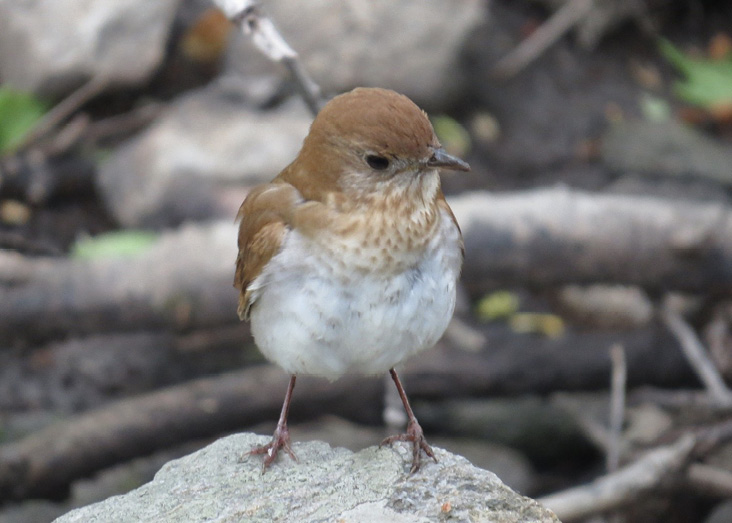
Veery. Photograph by Aidan Kiley.
Fall: Deer Meadow is the best location for fall birding in Larsen. In October or November, the Deer Meadow loop and open field with ragweed patches and small conifers in the meadow provide habitat for many sparrows, warblers, and more common visitors. If you are looking for a spot for morning flight, give Deer Meadow a try. It is a perfect vantage point for watching both passerine and nonpasserine migrants moving over. October through mid-November should be the best time of year to try morning flight there, although earlier in the fall could prove productive for warblers and raptors.
Fall migration in the sanctuary other than in Deer Meadow is not as good as in the spring, but it can be fruitful. The areas around the building and Dirty Swamp Pond are excellent for fall birds. Clay-colored, Lincoln’s, and White-crowned sparrows have been recorded, plus Nashville, Tennessee, and Mourning warblers. At sunset in late August and September, nighthawks show nicely near sunset. The feeders and flower garden near the building attract sparrows and other typical migrants. Although there has been minimal reporting to eBird for the rest of the sanctuary, Larsen is certainly a good place to bird throughout the fall.
Hawkwatch: From 1972 to 1989, the sanctuary had an official hawkwatch site. Deer Meadow, in the northern corner of the sanctuary, has a wooden platform that provides an excellent view of the skies on a cool fall day. This location recorded a significant number of hawks in its day, with Sharp-shinned Hawks and Broad-winged Hawks being the species on record with the highest frequency. Golden Eagles and Northern Goshawks were regular visitors in late October and November. There were at least three days with four Goshawks in the early 80s. Earlier in the fall is also good for raptors as the hawkwatch data suggest. The location is a good spot for morning flight and raptors, but there is no regular hawkwatch observer on fall days. On good finch winters in recent years, the platform has been productive for many Purple Finches, siskins, and other fall flyover passerines such as American Pipits and Cedar Waxwings.
General information
My favorite walk in the sanctuary is to walk the Streamside Trail and then cover Chiboucas. The Streamside Trail takes you over a boardwalk that is productive for migrants and has breeding Louisiana Waterthrush. Continue on the Chiboucas Trail, where there usually is a Red-shouldered Hawk nest in the vicinity of the “lightning tree.” Walking toward the Wildlife Pond, you will frequently see or hear Wild Turkeys and often hear calling Barred Owls. The sanctuary is typically quiet in the early morning, with few people. When the weather is nice it may be a bit crowded, so visit early to maximize quiet birding time. In the evenings it is rarely crowded, so that is also a good time to bird. Dogs are not allowed, unlike almost all other local spots, which makes birding quieter and hassle free.
The visitor center has a gift shop where bird seed, feeders, and other birder essentials are available. Ask an employee at the desk about birding the sanctuary, tips for exploring Larsen, and about becoming a Connecticut Audubon member. You can visit the raptor cages adjacent to the parking area when the building and gate are open. They have various birds such as Barn Owl, Barred Owl, Turkey Vulture, two American Kestrels, and a Red-shouldered Hawk.
The parking lot is at 2325 Burr Street, Fairfield, Connecticut, 06824. It is an easy drive from either Interstate 95 or the Merritt Parkway. From Interstate 84, take Routes 25, 8, or Interstate 91 to Wilbur Cross/Merritt Parkway (Route 15).
From the Merritt Parkway, take Exit 44 toward Fairfield/Reading. If you are coming from the south, turn right off the ramp onto Congress Street. Drive approximately 1.0 mile, and take a right onto Burr Street. The CAS Larsen Sanctuary is 1.1 miles on the left. From the north, turn left off the ramp onto Congress Street, take a quick left onto the Black Rock Turnpike (Route 58), and in 600 feet, turn right onto Congress Street. Follow Congress Street for approximately 1.0 mile, and take a right onto Burr Street; drive 1.1 miles to the sanctuary.
From Interstate 95, take Exit 21–Mill Plain Road. Proceed north on Mill Plain Road. In 2.3 miles, Mill Plain Road turns into Burr Street; continue straight for another 2.3 miles until you come to the CAS Larsen Sanctuary.
Aidan Kiley is a Connecticut native from the coastal town of Fairfield. You can find him spending hours at Lake Mohegan or obsessively searching for new county birds. He is an eBird fanatic and a regional reviewer and hotspot editor for Connecticut for eBird.